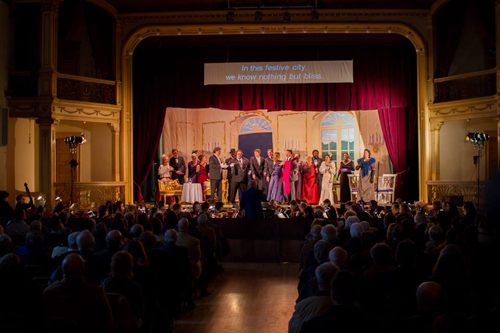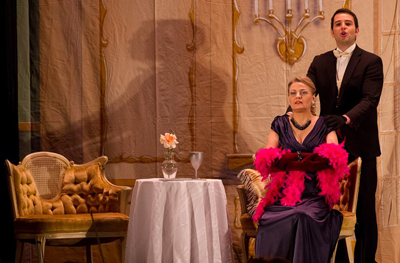by Daniel Hathaway

Traviata was staged in collaboration with Robert Cronquist and the semi-professional Cleveland Women’s Orchestra, who occupied a “pit” curtained off in front of the stage.
Opera Circle is a fearless company that operates as an extended family affair with high artistic aspirations. When everything clicks, its productions rise above the sum of their parts. Traviata enjoyed a trouble-free opening night on Friday with an attractive cast of well-matched singers and fine production values. The stage direction was shared between Cronquist and Dorota Sobieska (who is executive director of the company and as its prima donna, also sang the lead role of Violetta).
Though too noble in her bearing to be completely convincing as a courtesan who might sink the reputation of Alfredo’s family, Sobieska portrayed Violetta with vocal distinction and dramatic force. Her lower register sounded unfocused early on, but by the deathbed scene in the final act Sobieska was riveting in loud passages and she floated high notes with ease.
Tenor Matthew Miles was visually attractive and vocally splendid as Alfredo Germont, singing with handsome tone and flexibility. Baritone José Andrade brought a strong and penetrating vocal presence to the role of Alfredo’s father Giorgio. Smaller roles were effectively sung and acted by Nicole Wong (Flora Bervoix), Carey Wentzel (Annina), Douglas Olson (Gastone), James Binion (Barone Douphol), Dan Hild (Marchese d’Obigny), Shaun McGrath (Dottore Grenvil) and Jeremy Gilpatric (Giuseppe).
The well-dressed 11-member choral ensemble added both bodies and a thrilling boost to the company sound in the party scenes and managed to look festive and agile even in a shallow room. Some small bits of stage business made a big visual effect, like the colorful toss of papers at Flora’s party.
An opera without orchestra would be a sad affair, and the Cleveland Women’s Orchestra added depth and essential Verdian colors to the production. Though the low strings occasionally went astray and some of the tempos were on the slow side — the Brindisi needed some extra bubbles — Cronquist did an admirable job of holding musical matters together and his musicians created some lovely sonorities during the evening. One unlovely sound emanated from an electronic keyboard, unsuccessfully replacing a harp.
What Friday’s production lacked was a typical operatic audience. For sure they applauded and shouted lustily at the end of each of the four acts, but they seemed reluctant to put their hands together at the ends of arias and choruses, leaving some awkward blank spots in the action. Funny how what serves to interrupt the mood between movements of a symphony is exactly what’s needed to help animate an opera performance.
Photos by Eddy Wong.
Published on ClevelandClassical.com March 4, 2014
Click here for a printable version of this article.







